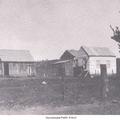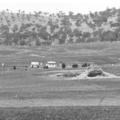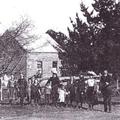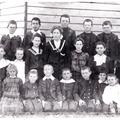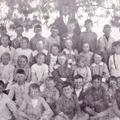< Early Canberra Government Schools
Narrabundah ('Crossroads') School [1894 - 1923]
Previous Name/s: Duntroon
Narrabundah school was created in 1894 so that children on the south side of the Molonglo would not have to cross the river to attend school at Springbank. At that time, the nearest southside schools on the Canberra Plain were at Bulgar Creek (called Yarralumla) and Long Gully (called Nerrabundah, on Yarra Glen), both well beyond the official two mile limit for children walking to school.
The application for a school for 'South Canberra' was ostensibly made by Charles Kaye but his name was signed by wife Letitia, who was the main agitator in the matter. There were not enough potential attendees to justify a full-time provisional school and parents were reluctant to provide accommodation for a half-time school but it was that or nothing. In the end Letitia persuaded the locals to make available a slab hut near Scott's Crossing.
The department called the new school Duntroon and staffed it on a half-time basis with Springbank, so although children no longer had to ford the river their teacher, Donald Robertson, did. All of Letitia's good work was undone when both Springbank and Duntroon were closed eighteen months later in favour of a single full-time school that the department opened in St John's schoolhouse. Children were again fording the river.
In 1900 the Kayes petitioned again and upped the bid. They wanted a modest 10-child purpose-built classroom to replace the old bark hut, which had one small window, a clay floor and was in poor condition. The department would go no further than to reopen Duntroon and pair it half-time with Malcolm Vale school in the Majura Valley. The inspector passed the accommodation problem back to the parents: the Scott's Crossing hut was too far gone; how would they replace it? Patrick Sheedy had a ready answer; he offered to relocate the former Long Gully schoolroom at his own expense.
And so it was dismantled and moved, but not to Scott's Crossing. Tom Kinlyside had suggested a more central site nearby at the junction of the Yass-Cooma and Queanbeyan-Uriarra roads. The Campbell estate was prepared to lease two acres at a peppercorn rent and it was there that the new Duntroon/old Nerrabundah schoolroom opened in 1901. Enrollments grew and in 1903 the school was given full time Provisional status. By 1904 there were enough pupils for it to become a Public School, obliging the department to provide a rather larger building than the one the Kayes had sought four years earlier. The senior inspector estimated that the £80 cost could be saved if instead the children were 'conveyed' daily to Queanbeyan, taking the children to school rather than a school to the children. The department, missing the point entirely, tartly observed that conveyance was a matter for parents and that accepting departmental liability was 'not in contemplation or desirable'.
Teacher William J. Rolfe was determined to improve the windswept new site. He planted trees (some of which still stand at the junction of Empire Circuit and Fitzroy St in Forrest) and sought fencing materials to keep out rabbits. The department approved but trees take time to grow. Even senior inspector Flashman conceded that there was a problem.
The schoolroom is situated on an exceedingly exposed plain where cold winds are very common. The school room is not lined and the wind finds its way through the boards and makes the room cold and uncomfortable in winter and most of the summer months.
Flashman recommended half-height lining; the department decided to go all the way. Rolfe had earlier raised another inconvenience.
"I beg to respectfully inform you that letters addressed to me at the Public School, Duntroon, Queanbeyan are frequently sent on to Duntroon station. Duntroon Station is on the Yass-Queanbeyan mail route, whereas Duntroon Public School is on the Queanbeyan-Uriarra. I would suggest that the name of the school be changed from Duntroon to Nerrabundah, the name of the locality. If the name be changed to Nerrabundah much inconvenience and annoyance now caused by the delay in receipt of letters will be guarded against."
The department concurred but, in subsequent paperwork, sometimes spelt it Narrabundah, another common usage for the locality. The locals were sensitive to the risk of confusion, knowing that there had already been a Nerrabundah school at Long Gully. Some would have remembered that one teacher when told orally that he was posted there had turned up at Narraburra near Temora. Their commonsense remedy was invariably to refer to Rolfe's school as 'Crossroads'.
Rolfe experienced the usual difficulties in finding nearby accommodation at a bush school without an attached residence. In 1907 his problems were compounded by a whooping cough epidemic that killed several local children. Rolfe's own were dangerously afflicted, his wife was ill, and no landlord would risk taking them in. Parents withheld all of the students, most of whom nevertheless contracted the disease, and the school was closed for three weeks. Two months later the department found Rolfe a more suitable post.
The next two teachers could find no accommodation closer than Queanbeyan. M Hannan patiently commuted for five years before venting his frustration, accusing the senior inspector of 'practically false pretences' in inducing him to accept the appointment. His successor, Samuel Crowther, was granted forage allowance (although his vehicle was a bicycle) until such time as he could find a house within three miles of the school.
The transition from state to federal jurisdiction was not without some misunderstandings. When 12 March 1913 was declared a public holiday in the federal territory Crowther closed the school and took the children to the national capital commencement ceremony, held half a mile away. He was asked why he had not sought leave and replied that he had taken the public holiday for granted. The inspector recommended that leave be approved retrospectively, but without pay.
By the time of WWI the school was again straining its accommodation, with over 40 children attending. Unlike the NSW department, the territory had embraced conveyance and children were being coached to Crossroads from beyond the two-mile limit. Crowther reminded the territory authorities that there was a disused publicly-owned schoolhouse at Bulgar Creek. It was demounted, taken to Crossroads and married to the 1904 building, doubling the latter's capacity.
The construction of a residence for the teacher was approved in 1919, but action deferred. The little bush school closed in 1923, made obsolete by the Federal Capital Commission's Telopea Park school, which stands just a few hundred metres from the former Crossroads site.
Notes and Links:
Officially named at first 'Duntroon' School, the Narrabundah school building was situated on two acres of land leased at a peppercorn rental at the intersection of two roads on the Campbell property 'Madura'. It was popularly known as the 'Crossroads' School. The school opened on 23 January 1894, with Mr Donald Robertson as teacher, and an enrolment of 23 pupils. The school operated as a Half Time school with Canberra School until it closed in July 1895. The school remained closed for six years until it was re-opened with 20 pupils in 1901 as a Half time school with Malcolm Vale School.
As the nearest residence where the new teacher, Mr William J Rolfe, could secure accommodation was six miles away, he was granted a forage allowance of £20 a year to meet the expense of riding or driving a sulky to school each day. In 1912 the teacher Mr Samuel Crowther, who rode a a bicycle from Queanbeyan each day, received an annual allowance of £5. By 1916 the next teacher, Mr George Kemp, was riding a motorcycle for which he got an allowance of £15 a year. Mrs Kemp rode to the school in the side car to instruct the girls in needlework.
In November 1901 Mr Rolfe planted trees and fenced the school grounds to keep out rabbits, as the site was bare and windswept. The cost of fencing two sides of the school grounds was £8.12.6 including 15/- for 200 yards of barbed wire. Wire netting was 2/6 a roll.
The school building was very old, having been removed from another site in 1894. It was too small, and. as reported by the District Inspector Mr Flashman was "quite beyond repair or improvement". Tenders were called for a new building and on 24 June 1902 a contract for £68.10.0 was signed by Mr C. J. O'Rourke of Queanbeyan. The new building was completed on 19 September .
In 1904 there were 26 children on the roll and the average attendance was 19.1. It was in 1904 that the name of the school was changed to 'Narrabundah' to avoid confusion with the nearby Duntroon station.
On March 31 1913 the teacher, Samuel Crowther, advised the District Inspector at Goulburn: 'I beg to state that the Nerrabundah Public School was closed on the 12th instant on account of it being proclaimed a public holiday for the Federal Area in which the school is situated. I beg to state that all the children were present at the ceremony of the naming of the Federal Capital City, the site of the ceremony being approx. half a mile distant from the school'.
In July 1916 the school was enlarged. Mr Kemp, Crowther's successor, reported: 'the original building was 18' x 14' with 10' wallplate. Last quarter's enrolment was 46. The school building at Bulga Creek is being removed and added to the old building at Nerrebundah. I will then have ample room'. By July 1921 however, Kemp reported that it was difficult to keep up the attendance at the school 'as the coach has again ceased running, perhaps for months'. He continues 'I had an attendance of 13 today, whereas had the coach been running I should have had 43'. Most of the pupils by this time came from families who were working at the powerhouse and the brickworks.
The school finally closed in September 1923, just after the new and nearby school of Telopea Park had opened in July
Narrabundah School – Arthur Freeman's story
"My sister, one of my brothers, and I were the first three pupils enrolled at Telopea Park School when it opened. We went to the old Narrabundah School for a while and one day when we were having a great time, packing up all the books and things to take over to Telopea, Mr Henry the Headmaster, decided to start the roll for the new school. Mabel, Ernest and I just happened to be closest to him at the time, so we were first three in the enrolment book.
We used to walk everywhere in those days, across the bare paddocks from Westlake to school, picking up our friends the Stevens on the way. My brother hated wearing boots and he always took them off, tied the laces together and hung them around his neck on the walk from school. He didn't do that when Mum used to take us for walks to church at St John's, or to Duntroon to visit someone, or occasionally to see a moving picture, which the Freebodys used to put on at the hall there". (p.44)
[Narrabundah School closed in September 1923. Mr Cecil L Henry was the first Headmaster at Telopea Park, which opened its doors on 2nd October 1923. He had one assistant, Mr James Newman. Initial enrolment was fifty-eight]
Harry Trevillian's story
"I first went to school at the Narrabundah School, which was near the Fire Station at Manuka. I remember the big fireplace in the old schoolhouse. Mr Kemp was the teacher and he used to ride a motor bike and sidecar in from Queanbeyan where he lived. He was a great gardener and he used to have us kids growing a vegetable patch. On several occasions when I was going to Narrabundah School there was heavy rain, and we used to have to get Billy Webbʼs horse and sulky to go through the flooded creek even though the school was only a short walk away.
I thought Narrabundah was a pretty good school, but my father reckoned there was a better teacher over at Duntroon, so I had to go there until Telopea Park School opened in 1923. I went to Duntroon school with about eight of the kiddies who lived around the Power House - we used to walk to school across the weir. I first started to smoke down at the weir - lit up willow roots with no paper. It put me off smoking until I was about twenty-two or so.
I think we were about half boys, half girls who walked over to Duntroon school - I know the Gray boys used to be with us and when we were walking home we used to pinch quinces from the Edlingtonʼs farm. The Hills had the first market garden and the Lloyds some years later and both had greengrocers shops in Kingston. Hills farm was out at Pialligo - they had good water melons - when they were ripe we would sometimes be late coming home from school". (p. 24)
Stories from 'Past Images, Present Voices'. Canberra Story Group, 1996. Collected and compiled by Val Emerton.
Location Map
Related Photos
Teachers
- Robertson, Donald
Half Time, 01/1894 - 07/1895 - Rolfe, William Joseph
08/1901 - 09/1907 - Hannan, Mr Matthew
09/1907 - 12/1912 - Crowther, Samuel
12/1912 - 04/1916 - Kemp, George Henry
05/1916 - 09/1923
NSW Government schools from 1848
- Narrabundah ('Crossroads') School (external link)
< Early Canberra Government Schools
If you are able to assist our work of identifying, documenting, and celebrating the early bush schools of the Canberra region, please contact us or .


